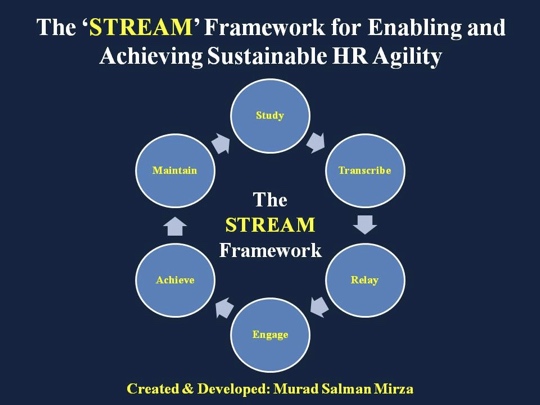Achieving HR Agility w/ the ‘STREAM’ Framework
Human resources has historically been criticized for being sluggish in terms of its role within the organizational realm. Frustrations abound among disgruntled/dissatisfied employees who see HR as the “enforcer” of the leadership’s mandates, while being unable/incapable/hapless to address or alleviate their concerns.
The internal discontent/rumblings are routinely amplified through the corporate grapevine and even positives steps from the leadership are viewed with suspicion. HR is even pitted against HR in organizations where casual conversations about the ability of HR in other organizations to placate all the key stakeholders and galvanize initiatives for organizational excellence.
Such “grass is greener” thinking often only further erodes morale within the organization and deflates its competitive strengths—which can have serious consequences when trying to keep up with the competition and pace of the digital world.
Empowering Greater HR Agility
Consequently, it is becoming increasingly critical for the leadership of progressive organizations to enable/facilitate the HR profession to respond more quickly and effectively to changing employee expectations, workplace disruptions and business requirements to stay on par with/ahead of worthy competitors.
The case for HR agility is further reinforced by the following factors:
Brokering and Discovering Unknown Talent: ?This reflects the need for skill maximization within the current workforce which requires keen exploration and active encouragement to help them discover/display their capabilities on a wider bandwidth.
Building an Adaptive and Ethical Culture?: This reflects the entrenchment of core values within the multi-generational workforce as the primary source of employee engagement and value-driven initiatives for a more cohesive workplace.
Developing a Learning Organization?: This reflects the enhancement of capabilities that robustly infuse skills and expertise within the organizational fabric while laying a strong foundation for consistently enriching the knowledge bank.
Fostering Worker Mobility: ?This reflects the career optimization for ambitious employees who are committed to expanding their skill sets and accommodate change with a positive frame of mind by proactively adapting to disruptive influences, e.g., proactively aligning their career paths with the inclusion of AI-enabled entities in the workplace.
Applying Science and Fact-Based Analytics: ?This reflects the refinement of decision-making that comes from adopting a scientific approach coupled with fact-based analytics for taking calculated risks and minimizing the chance of erroneous judgments prone to grave consequences.
Enter the STREAM
Consequently, the following ‘STREAM’ framework is being presented that can be used to illuminate the path for enabling and achieving sustainable HR agility.

(S) tudy Phase
This refers to the deployment of suitable formal (employee surveys, reviews, etc.) and informal (mentorship, team events) means for correctly assessing the issues. It entails careful collection of authentic data and its meaningful conversion/compilation into viable information that can facilitate thorough analysis for astute decision-making.
(T) ranscribe Phase
This refers to the prioritization of the highlighted issues and associated findings that have come out of the Study Phase. It entails the formulation of desired goals and objectives coupled with the structuring of relevant information into a formal report that has been uniformly formatted in a clear, error-free and presentable manner for all the key stakeholders to facilitate review and discussion.
(R) elay Phase
This refers to the communication of the formal report developed during the Transcribe Phase to all the key stakeholders. It entails distribution in an open, transparent and constructive manner with a cordial invitation for answering any associated questions to create a robust ‘buy-in’ and develop consensus for desired goals/objectives.
(E) ngage Phase
This refers to the channelization, optimization and utilization of the required resources to launch appropriate measures/action plans stemming from desired goals/objectives that have been disseminated during the Relay Phase. It entails prudent operational planning with appropriate risk assessment/mitigation measures for gauging the efficacy of available options, selection of suitable team under capable leadership (if needed), defining key milestones/performance indicators, close coordination/collaboration with all the relevant stakeholders and associated monitoring mechanisms.
(A) chieve Phase
This refers to assuring, ensuring and confirming the attainment of results in congruence with the desired goals/objectives and the operational plans developed during the Engage Phase. It entails timely review of key milestones/performance indicators and taking appropriate corrective/preventive actions to prevent deviation from the desired course of action.
(M) aintain Phase
This refers to systematizing, sustaining and refining the whole process with key lessons from the previous phases. It entails an honest self-reflection and a comprehensive review that engenders a solid commitment to consistently improving the ‘client experience’ of other functions with the HR Function. It also includes the timely enrichment of the knowledge bank that is openly accessible to all team members.
Fundamental STREAM Drivers
Some of the key drivers for the aforementioned ‘STREAM’ framework are as follows:
- Robust and unwavering leadership support;
- Multi-channel and clear communication;
- Collaboration and cooperation;
- Proactive and meaningful initiatives;
- Constructive and insightful feedback;
- Efficient and effective resolution;
- Consistent and prudent monitoring;
- Timely and honest reviews;
- Healthy appetite for fruitful improvement; and
- Innovative mindset for nimbleness, e.g., HR SWAT teams
Parting Insights
The empowerment of HR and the agility this permits reflects the confidence of the corporate leadership in the ability of the HR profession to rise above the “noise” of conventionalism and become a recognized strategic partner in organizational success. It does not happen in a vacuum and needs HR professionals to be functioning at a high level of well being and mindfulness—as it doesn’t make sense to attach agility expectations to a function that is itself in need of a saviour.
How agile is your HR?








